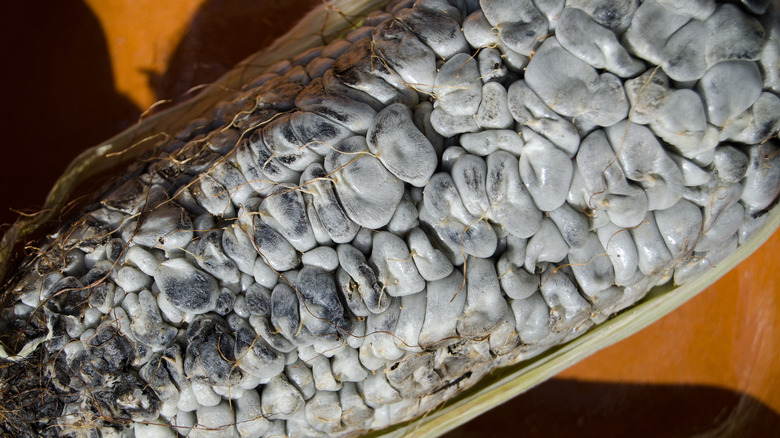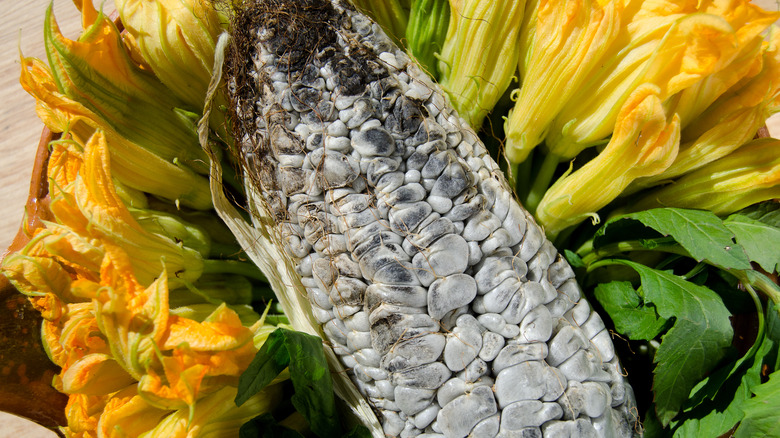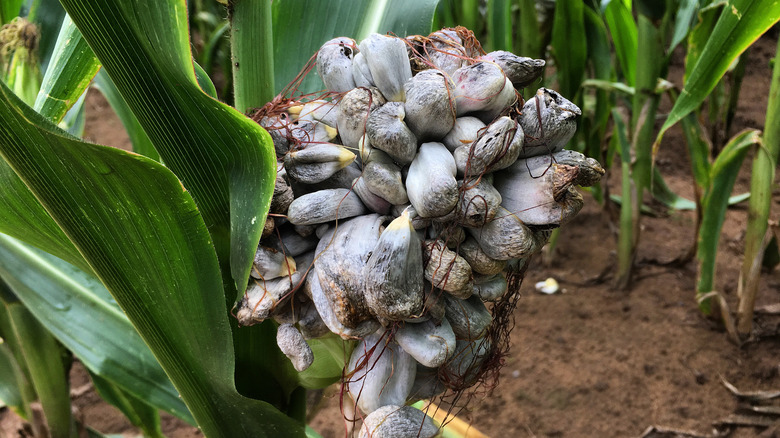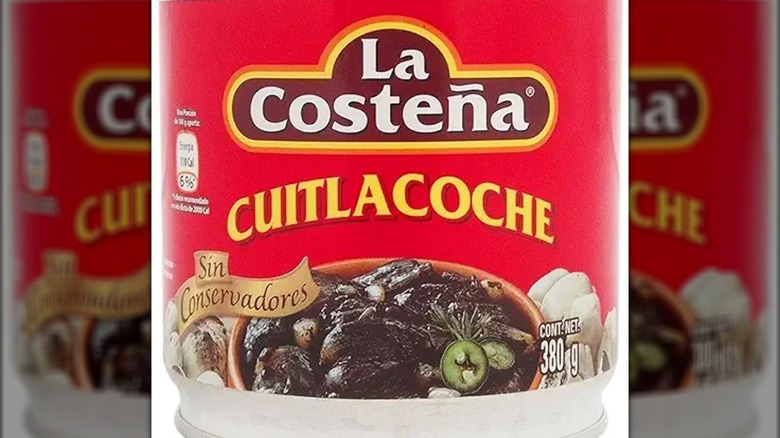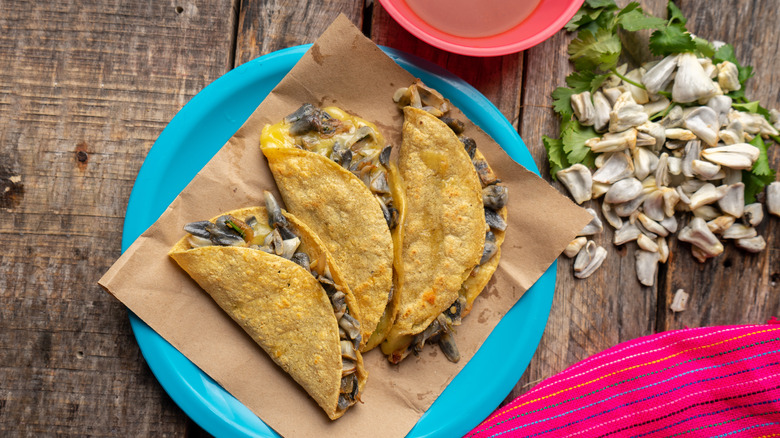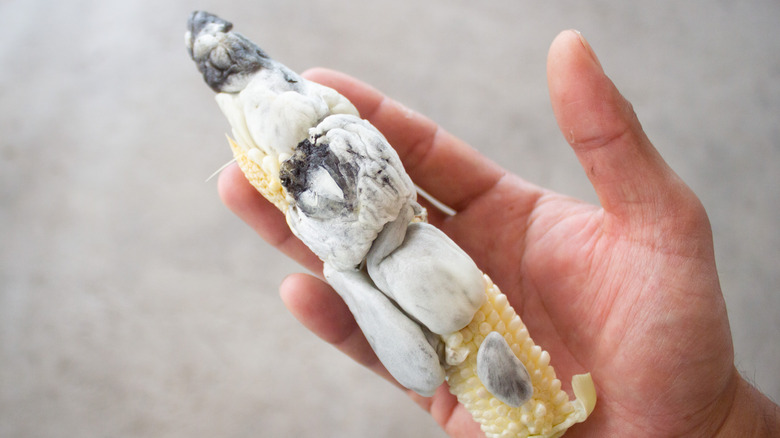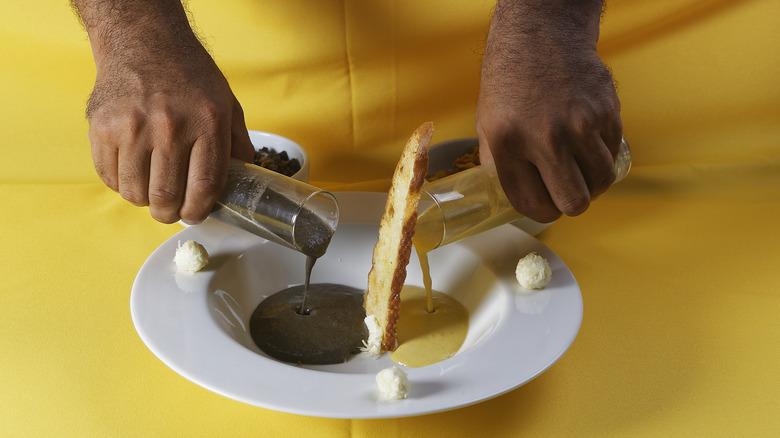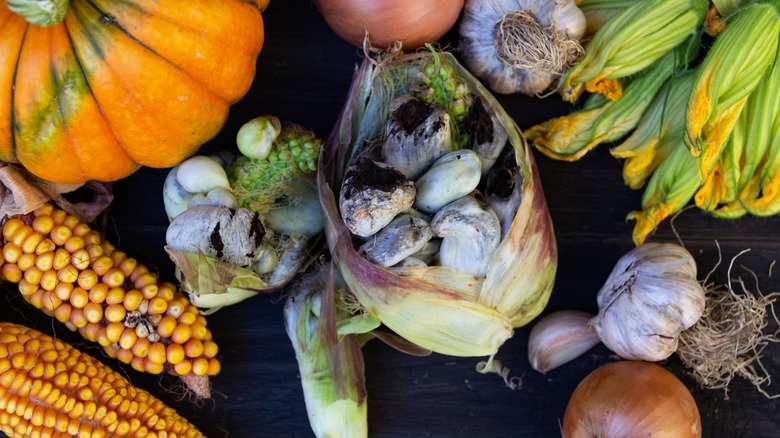Huitlacoche: The Corn Fungus You Should Be Cooking With More Often
We may receive a commission on purchases made from links.
It's probably one of the least appetizing-looking foods you'll ever find on your plate. Mottled and gray, it looks like a frightening growth you'd want removed as quickly as possible. Cooked, it breaks down into a weird, black, goopy mess. And, its name is almost impossible to pronounce from reading it off the page.
But, what should be a PR nightmare is actually one of the most enigmatic ingredients in Mexican cuisine and is absolutely delicious. Huitlacoche (weet-la-KO-chey), a fungus borne of corn and much loved by Mexicans since the pre-Columbian era, is among the world's most unusual foods. While Mexicans have long been tucking it into tacos and quesadillas, in more recent years, the country's chefs have been taking the ingredient in new directions, plating it up in some of the world's highest-rated restaurants such as Mexico City's Pujol and Quintonil.
Huitlacoche is used in various dishes, from soups and delicate crepes to tamales and tlayudas. It's even been known to appear in ice cream. While it can be used raw and added to salads, cooking it brings out its full earthy flavor.
Cooks and scientists in countries outside Mexico are experimenting and researching the fungus. They are looking not only for new ways to enjoy it but also for ways to produce it on a large scale much as truffle enthusiasts outside Europe have been working to grow them in their own countries.
Huitlacoche is a fungus
"Huitlacoche is actually a corn disease, caused by the fungus Ustilago maydis," according to the University of Wisconsin extension office. The huitlacoche fungus releases a legion of black spores that are whipped up and transported by the wind as well as surviving in the soil for years.
Eventually, huitlacoche appears as bulbous, unsightly growths on the ears of corn, although it can also grow on the stalks and tassels, too. While we can only imagine how the first farmers of corn in pre-Columbian Mesoamerica reacted to infestations — probably much like modern farmers outside of Mexico today who do whatever is necessary to wipe out the infestation — those early farmers made an important discovery: that weird-looking fungus is delicious.
Although often promoted now as Mexican truffle, huitlacoche can easily be appreciated on its own merits. Mexican farmers now actively cultivate the fungus, and can command four or five times as much for an ear of infected corn as they can for a healthy ear. Beyond its culinary uses which, in Mexico, reach into a wide variety of foods and dishes, it's also being researched for medicinal and other practical applications including industrial uses and even in wine production.
With huitlacoche, fresh is best
As is the case with most produce, fresh is best. Not only does huitlacoche taste best right when it's harvested — much like corn — it also degrades pretty quickly and should be used within a few days of harvest. If you can't use it right away, keeping it at 39 degrees in the refrigerator in a paper bag, will keep it in reasonably good shape for several days.
Unless you live in an area with a large Latino community and farmers nearby who are plugged into that community, you're most likely to find it canned, dehydrated, frozen, or in jars at Mexican or Latin American markets. The quality, while not bad by any means, won't be on par with fresh but you can still plan on a pretty tasty meal.
In jars, it's most likely preserved in brine, and rather salty. In that case, give the huitlacoche a thorough rinse under cold running water, draining off as much of the excess water as you can. If canned, it may already be seasoned and will likely contain quite a few uninfected corn kernels, as well. Frozen and dehydrated are your best bets for a flavor that's both unadulterated and as close to fresh as possible. Should you find it fresh at a farmer's market, it will probably come either cut from the cob or still attached (in which case you'll get to see it in all its funky, bulbous gray glory).
How to store huitlacoche
Once you have your order of huitlacoche in hand, whether it be canned, dehydrated, jarred, or frozen, you'll find the processed varieties stored rather easily. Canned huitlacoche can be stored anywhere from two to five years, according to the USDA, but if frozen, you should use it within a year.
One of the problems with freezing it, though, is that when it's thawed, it will begin to ooze liquid. One way to deal with that is to cook the huitlacoche before you pop it into the freezer, adding whatever seasonings and ingredients you like. Once you're ready to remove it from teh freezer and pop it in a recipe, the corn fungus won't look quite so beaten down. Producers of dehydrated huitlacoche suggest not holding it longer than about 12 months. And, that jarred stuff in the brine? Once it's opened you should use it within a week or so.
Huitlacoche is noted for its complex flavors
Perhaps befitting its weird appearance, huitlacoche is a distinctively flavored fungus. James Beard Award winner Chef Alan Bergo, formerly a contestant on Hulu's "Chefs vs. Wild" and an experienced forager, describes the fungus as having an "earthy flavor, with a slight bitterness and a not-unpleasant metallic taste, sometimes, but not always followed by a corn-like sweetness."
The late Diana Kennedy, the writer who spent most of her life studying and exploring Mexican cuisines, described it as "perfectly delicious, with an inky, mushroomy flavor that is almost impossible to describe." That might stem from the fact that huitlacoche also contains high levels of two flavor compounds, vanillin and sotolon, which are responsible for giving fenugreek and maple syrup their particular flavors.
Of course, huitlacoche's complexity derives from more than just flavor compounds. Research indicates that the various foods we eat contain some selections of around 230 odorants, but most foods contain only between three and 40 of them. Huitlacoche contains 32.
Where to find huitlacoche
If you live in central Mexico, huitlacoche isn't difficult to find. It's most readily available during the summer rainy season from June through October but we've found it even in February at any number of markets in Mexico City, for example. Now, if you live in the United States, that's another matter entirely.
While huitlacoche is growing in popularity around the U.S., it's still a challenge to find. Despite its availability in Latin American grocers, for example, there's no guarantee that your nearest market will have anything other than canned or jarred varieties if that. A quick tour of several Mexican and Latin American grocery stores in San Francisco recently only turned up huitlacoche in jars, with their salty brines. But, it is turning up in farmer's markets around the country. If that isn't an option, either, you can easily order it online from a growing number of sources.
How to cook with huitlacoche
Huitlacoche isn't difficult to prepare and it shows up in a fair number of dishes as a result. Of course, preparation also depends upon what condition it's in when you purchase it. If it's frozen or canned, it should be ready to go.
If it's dehydrated, you'll need to rehydrate it first, by covering it with water until the kernels — or, more correctly, galls — are plump again. 100 grams of dehydrated huitlacoche will produce about one pound rehydrated. From there, you can cook it as normal.
Should you find yourself fortunate enough to get your hands on fresh huitlacoche, you may find yourself working with one of two options. If it's already been cut from the cob, then all you'll probably need to do is to check it for any impurities such as overripe galls or tassels, or some other bits of detritus. If yours comes still on the cob, treat it much as you would regular corn. Slice the galls from the cob as you would regular corn kernels. Then you're ready to cook!
Huitlacoche, most simply, can be fried up with some onion, garlic, chilies, and the creosote-tasting herb, epazote. From there, use it to fill quesadillas or tacos, or add it to stews or soups. Some of Mexican cuisine's top chefs turn it into a richly flavored sauce for use with other ingredients. Your imagination is really the only limit to its uses.
Huitlacoche is a nutrition powerhouse
While pre-Columbian farmers might not have understood huitlacoche's complex nutritional value, they no doubt saw the results of adding the fungus to their diets. Ongoing research demonstrates that huitlacoche is very, very good for you.
Huitlacoche is very high in fiber and protein. In fact, it has more than four times as much protein as a similar amount of corn and contains pretty much all amino acids, which are necessary for synthesizing proteins and nitrogen in our bodies.
Combined with corn in, say, a corn tortilla, huitlacoche is a complete protein. It's convenient, too. Since huitlacoche already grows on corn, you're getting a complete plant protein from a single source. There's also evidence that huitlacoche is high in antioxidant compounds, and can help people maintain healthy levels of cholesterol. Finally, huitlacoche has been shown to contain prebiotic compounds that contain anti-diabetic qualities, which can help prevent spikes in blood sugar levels and help them manage their diabetes.
